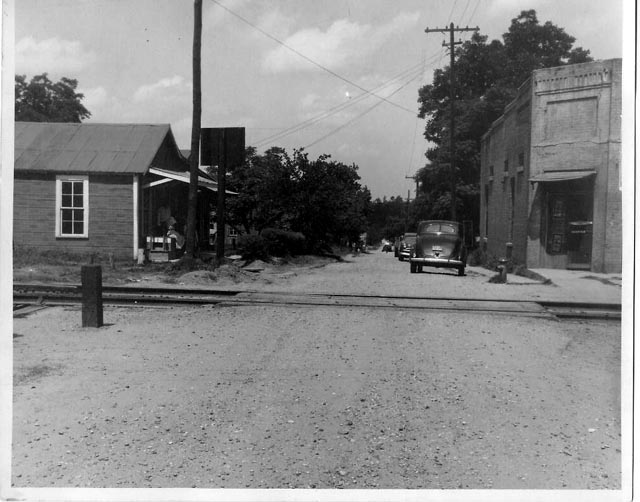Good morning all.
The date is in the 1950s, in a small town with black top roads and one main street.
Was this signal used then or would there be just cross bucks indicating a rail road track?
Thanks for any help. [bow]
Lee
Good morning all.
The date is in the 1950s, in a small town with black top roads and one main street.
Was this signal used then or would there be just cross bucks indicating a rail road track?
Thanks for any help. [bow]
Lee
No, but it depends on how much traffic is on both the railroad and the road. Many times small brachlines used just crossbucks. So use it.
I would say it would date until the first train came along. Then it would be history.
I knew that a, uh uh (wise burro), was going to make a comment as soon as I sat the signal down and took picture. [:-^] any way I thought we all could get a chuckle. [swg]
Have fun.
Lee
And thanks Horton
This is a photo I donated to a university library historical archive in Natchitoches, Louisiana. It was dated 1949. Photographer carefully noted his position and direction. It may have been a court exhibit.\

NO crossbucks even. I imagine the sign at left says “Railroad Crossing” on the front but we can’t see it.
I was raised in a small town (Pop. 3200) in southern Illinois that had an Illinois Central two-track mainline running through it. One of the city street crossings had electric signals with gates installed sometime around 1949-1950. There were a couple of other crossings close-by that had only crossbucks for many years thereafter.
The Long Island Railroad had that type of crossbuck-plus-flasher signals in the WWII era. That’s one of the things I remember from my pre-school years.
Another is the scream of diving Hellcats. We weren’t far from the Grumman Iron Works at Bethpage…
Chuck (Modeling Central Japan in September, 1964)
It’s not a small town in the 1950s, but—
Houston had a traffic safety study of railroad crossing made in 1953. A copy of the engineering study was preserved in the University of Houston library. Went over the function and capacity of each yard, how many trains/day use each track etc.
Individual crossing studies of about 20 spots, with train and vehicle traffic counts. Most individual crossing studies had a photo from motorist’s view and one from train view.
I copied 25 or 30 pages from the study and glued them together. My photocopy of the tiny photos would not scan acceptably. I ha ve some photos of the spots made at various times…
Collingsworth 7 tracks including crossing of Southern Pacific T&NO line with Houston Belt and Terminal in the middle of the street intersection.
I like the look of wig-wag signals. There were still over 1000 in use in 2004.
I have early childhood (early 1950s) memories of wig-wag signals where the Sacramento Northern crossed a downton street in my hometown of Concord, CA. Locally, I still see them in Pt. Richmond and Niles Canyon.
One factor often was the frequency, type, and speed of trains on a given line. In the town I grew up in, every crossing had either lights and gates or lights and a wigwag because the C&NW ran the “400” passenger train through town at speeds just under 100 mph. Even the most modest street had protection beyond crossbucks.
Another was the dangerousness of the crossing itself – sightlines, cuts and curves and that sort of thing. Unfortunately dangerousness often had to be proven by the number of accidents.
History also plays a role. If back in the day a railroad was concerned enough to have a manned crossing – meaning a person in a shanty would lower gates or stand at the crossing with a lantern to warn traffic, then that crossing would likely be modernized comparably: lights, or lights and gates. A crossing that was always just crossbucks would likely remain so unless the nature of the street or railroad traffic changed, or the railroad decided greater protection was needed, or state regulators ordered greater protection.
Cities and towns would often petition their state railroad commission to direct a railroad to install a protected crossing – or upgrade the level of protection that existed. A well stocked reference library often has those dusty volumes of railroad commission decisions. They can actually yield some good modeling information, sometimes even maps or drawings or photos of situations.
Google Books has several volumes of the Wisconsin railroad commission decisions in the early 1900s on many matters, including grade crossing protection petitions. That is the only state I have looked for but there may be many others.
Dave Nelson